AMD Announces the 7th Generation APU: Excavator mk2 in Bristol Ridge and Stoney Ridge for Notebooks
by Ian Cutress on May 31, 2016 10:00 PM EST- Posted in
- CPUs
- AMD
- APUs
- Notebooks
- Carrizo
- Excavator
- Bristol Ridge
- Stoney Ridge
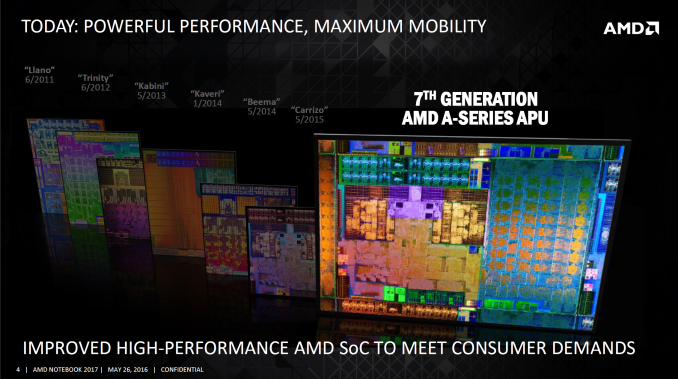
The Carrizo SoC, using Excavator cores, was touted in the press as being the biggest upgrade to the base Bulldozer design since the introduction of Bulldozer itself. This was as a result of new high-density silicon libraries, a new voltage/frequency response unit based on internal sensor data, a redesign of the metal stack to afford high density, improvements to caches and scheduling, improved video units for 4K decode, and a mobile-driven focus for the platform. Today AMD is launching the second version of Excavator, based on an updated core, in two forms: Stoney Ridge for entry level notebooks and Bristol Ridge for mainstream devices.
AMD’s future roadmap, at a high level, has been known for some time. First another crack at the Bulldozer architecture, and then we get the new microarchitecture the generation after. On a high-level, that’s a good thing to know. The issue has been that no-one has been able to get hold of deep details, and it does not help when faked slides are posted, outed as fakes, and then reposted continuously anyway. AMD took the lid off their press deck late last week, showing that the last crack at Bulldozer will be mobile driven like the last generation. It should be noted that AMD declined to comment about future desktop platforms at this time.
| AMD APU Generations | |||||||
| 1st | 2nd | 3rd | 4th | 5th | 6th | 7th | |
| Platform Name |
Llano | Trinity | Kabini | Kaveri | Beema | Carrizo | Bristol Stoney |
| Core | K10 / Stars | Steamroller | Jaguar | Piledriver | Puma | Excavator | |
| Released | Q2 2011 | Q2 2012 | Q2 2013 | Q1 2014 | Q2 2014 | Q2 2015 | Q2 2016 |
| Market | Main | Main | Entry | Main | Entry | Main | Both |
| Top SKU | A8-3550MX | A10-4657M | A6-5200 | FX-7600P | A8-6410 | FX-8800P | FX-9830P |
| Threads | 4C / 4T | 2M / 4T | 4C / 4T | 2M / 4T | 4C / 4T | 2M / 4T | 2M / 4T |
| Peak MHz | 2.7 GHz | 3.2 GHz | 2.0 GHz | 3.6 GHz | 2.4 GHz | 3.4 GHz | 3.7 GHz |
| TDP | 45 W | 35 W | 25 W | 35 W | 15 W | 35W | 35 W |
| IGP Family | HD 6620G | HD 7000 | HD 8400 | R7 | R5 | R7 | R7 |
| IGP Generation | VLIW-5 | VLIW-4 | GCN 1.0 | GCN 1.1 | GCN 1.1 | GCN 1.2 | GCN 1.2 |
| SPs | 400 444 MHz |
384 686 MHz |
128 600 MHz |
512 686 MHz |
128 850 MHz |
512 800 MHz |
512 |
The 7th Generation APU, in silicon, is by and large similar to the 6th Generation platform called Carrizo with some updates to help drive efficiency and improve performance. This is due to the updated Excavator core, primarily supporting DDR4 memory through the controller (similar to the R-series embedded AMD parts announced earlier), but also tweaks to the 28nm Bulk CMOS physical design that improved the voltage/frequency characteristics of the silicon. This combined with new AVFS (adaptive voltage frequency scaling) algorithms via improved through internal sensors enables AMD to offer a higher frequency for the same Thermal Design Power on the 7th Generation. With this, AMD is claiming that a move from a Kaveri ‘15W’ APU in 2014 to a new Bristol Ridge APU in 2016 can afford a 56% increase in raw CPU performance, or +10% over last year’s Carrizo.
Additional 6/1: AMD has shared with us die sizes and transistor counts. The Bristol Ridge dual module die, including the integrated graphics, comes in at 250.4 mm2 with 3.1 billion transistors. The Stoney Ridge single module die (including IGP) is 124.5mm2 and 1.2 billion transistors.
The improvements to the silicon design, such that a better die can be manufactured, was explained to provide about half the benefit from moving up to the 7th Generation. In this graph, the green line is designed to represent the frequency improvement for the same power between the older Carrizo process and the new Bristol Ridge process.
New in the 7th Generation APU will be what AMD calls 'Shadow Pstates', which AMD is combining with a check at POST on the quality of the silicon. As most silicon dies perform 'around an average point' so to speak, the absolute end AVFS application embedded in the die should need to cover AMD in the case of a bad die in a bad enviroment - this leads to a loss of excess headroom. What AMD will do with 7th Gen is apply a Shadow Pstate (or rather, a differential forced T-state) which allows the AVFS to change depending on the quality, age, degredation and performance of the processor. To put it simply, it allows the AVFS curve to ride nearer each CPU's specific characteristics, rather than a 'one size fits all' approach, and the user will end up with longer boost periods with a high quality die, or use less power when in lower frequency modes (and binning will take this into account).
Another piece in the puzzle is what AMD calls 'Skin Temperature Aware Power Management', which is perhaps a feature that has been on other platforms but AMD has been missing up to now. Despite the unwieldy name, this solution allows an OEM to place up to five sensors over the I2C interface on the SoC and use AMD's internal controller to allow for longer boost periods while the chassis is cool or adjust as necessary. By working with AMD, the OEM's placement of the sensors will allow AMD to suggest appropriate coefficients for their internal controller to respond in the correct way via firmware adjustments.
The big thing to note here, aside from the generational changes in the core, is that AMD is adjusting their mobile strategy. Previously the mobile APU line used low cost, low power ‘cat’ cores such as Bobcat in their entry level products and fatter Bulldozer based cores (like Steamroller and Excavator) in their mainstream line. For the 7th Generation, this goes away with both entry and mainstream parts now going full Excavator, and the two main differences being core count and power window. There’s also some adjustments to the naming of the processors which should help customers and OEMs choose the right part for their workloads.
The baseline platform will be Stoney Ridge, featuring one Excavator module for two threads and support for up to DDR4-2133 in single channel operation. These parts will be +1 GHz compared to the previous cat cores, and feature GCN 1.2 integrated graphics with support for HDMI 2.0, PCIe 3.0, the upgraded video decoder and codec engine, and thus support for VP9 and HEVC decode in AMD’s lowest parts. AMD is also touting a +50% graphics improvement over the last cat core generation at the entry level.
Users will be able to identify Stoney Ridge APUs based on their core count (one module, advertised as dual core), and that the APUs will carry the A9, A6 or E2 branding. The APUs will default to 15W, with only a small configurable TDP window for OEM (except the A9, which can run up to 25W).
The Bristol Ridge platform is for the mainstream. We get an expected dual module design for four threads, support for up to DDR4-2400 but with dual channel operation. Bristol Ridge APUs and Stoney Ridge APUs are the same socket, which means the can be used in the same design similar to Carrizo and Carrizo-L, and back with Carrizo it caused confusion as the high-end part in a platform designed for the low-performance part would only operate in single channel, reducing performance. We double checked with AMD about the whole single/double channel miasma that befell the Carrizo line, and AMD stated that while it is still an OEM decision, they are working closer with OEMs to ensure that users can get a more optimal configuration.
Users will be able to identify Bristol Ridge-based devices by the core count (advertised as quad core), and the APU will be in the FX, A12 or A10 branding. These SKUs will also have a ‘P’ in the name. These APUs will be in two different variants, 15W and 35W, each with a different name to be easily identified. There is a small configurable TDP window for each APU, however the 15W and 35W parts do not overlap.
One device with the 7th Generation APU was actually announced several weeks ago: the HP Envy x360. This device is going to be one of the premium products to use both Bristol Ridge and Stoney Ridge, offering a 360-degree laptop design, a 15.6-inch FHD or UHD display, both PCIe and HDD options, an option for a Windows Hello capable camera, premium audio and up to 10 hours battery life. We expect to see one during Computex this week, but the x360 should be on sale today. We checked with AMD on this too: the x360 will be offered in Stoney Ridge and Bristol Ridge formats, with the latter being dual channel.
The new APU SKUs are split by their FX/A12/A10/A9/A6/E2 branding and thermal design power. The main difference with a change in TDP is going to be the CPU frequency both in base and boost frequency, however some models and cTDP options may adjust the graphics frequency as well.
Each brand will carry ‘7th Gen’ in the image to confirm the use of a *Ridge APU. AMD is stating that APUs equipped with R5 and R7 graphics will allow for dual graphics configurations if the OEMs decide to use a comparable discrete graphics card, and we expect a couple of devices to be launched with this feature.
As the table also shows, users asked for TDP specific product numbers (myself included) and we have them here, especially in the Bristol Ridge parts. Any part that ends in ‘30P’ will be the higher TDP version. Despite this, AMD still offers that cTDP window for each APU, and it is up to the OEM to advertise if this is used. If the Carrizo devices are any indication, OEMs will not state nor will they open the option in the BIOS.
Information on the exact GPU configurations and frequencies should be on its way. We contacted AMD’s PR team after our briefing for this information, and they are sourcing it for us.
Additional 6/1: For the exact graphics configurations, we were given the following:
- FX 9830P: R7, 8 CUs, 512 SPs, 900 MHz max
- FX 9800P: R7, 8 CUs, 512 SPs, 758 MHz max
- A12-9730P: R7, 6 CUs, 384 SPs, 900 MHz max
- A12-9700P: R7, 6 CUs, 384 SPs, 758 MHz max
- A10-9630P: R5, 6 CUs, 384 SPs, 800 MHz max
- A10-9600P: R5, 6 CUs, 384 SPs, 720 MHz max
- A9-9410: R5, 3 CUs, 192 SPs, 800 MHz max
- A6-9210: R4, 3 CUs, 192 SPs, 600 MHz max
- E2-9010: R2, 2 CUs, 128 SPs, 600 MHz max
A story about new AMD products wouldn’t be complete without mentioning gaming bundles. AMD is offering OEM game bundles for any processor that is A9 and up, with the Bristol Ridge parts expanding in their options. It is up to the OEM to take on this offer and pass it on to the customer, so mileage on which products will offer this will vary.
Final Thoughts
Despite many users believing that AMD would be discussing AM4 and their desktop versions of Bristol Ridge at Computex, the opposite seems to be the case. AMD isn’t discussing it, and I’ve hit a solid wall with the motherboard manufacturers as well. If rumors are to be believed, based on a CPU cooling company Facebook post that was deleted, the socket is mostly likely the same dimensions as AM2/AM3, however we can’t even verify that. It would seem that whatever your prediction for hearing about new desktop products was, add at least a quarter.
But put this into perspective here. Bristol Ridge is still based on Excavator – a core that was initially designed to run at 15W in dual-module configuration. AMD stated at the Tech Day in 2015 that the higher TDP/frequency you run a Carrizo platform, the lower the differential to a 2014 Kaveri platform. AMD teased Carrizo on the desktop with the Athlon X4 845 at 65W for the FM2+ socket (and I apologize that I haven’t got around to writing the review fully yet), however this was one part without integrated graphics and a very low-frequency ceiling when overclocking. Despite this, Carrizo on the desktop was still a surprising performer, but only at the low powered part of the product stack. If we’re going to see Carrizo mk2 and Bristol Ridge on the desktop, it might only be for those lower power 35W-45W parts, and there’s no point releasing a platform with just 45W parts if it is going to evolve into the extreme platform with a Zen drop in: you need both, especially if each one is designed for specific markets. There’s an obvious line of thought I’m going down here, and while I won’t say it outright, the signs are getting less fuzzy as time moves on.
Desktop aside, we reviewed the OEM implementations of AMD’s Carrizo platform earlier this year and came away feeling that an opportunity to show off the hardware had been missed. I know that AMD took on board our points and discussed them internally, and hopefully working with HP on the x360 can show what the APUs should be able to do. We expect to see more 7th Generation device announcements at Computex this week, and I’ll ping AMD and HP for some hands-on time with a review unit in due course.



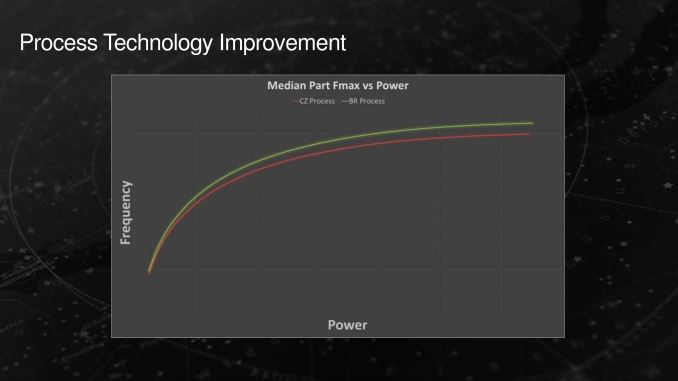
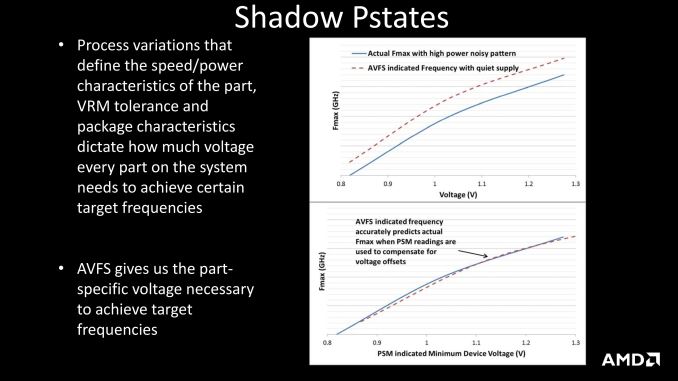
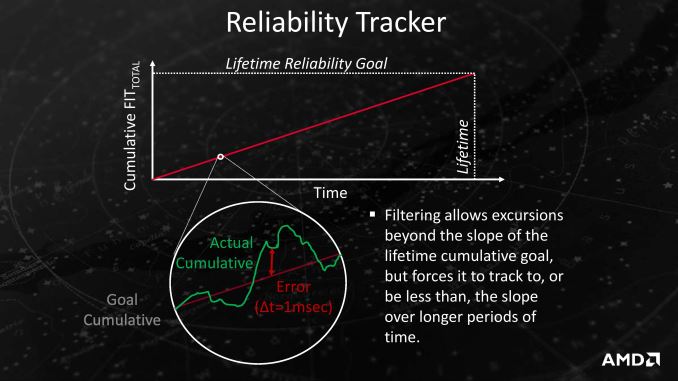
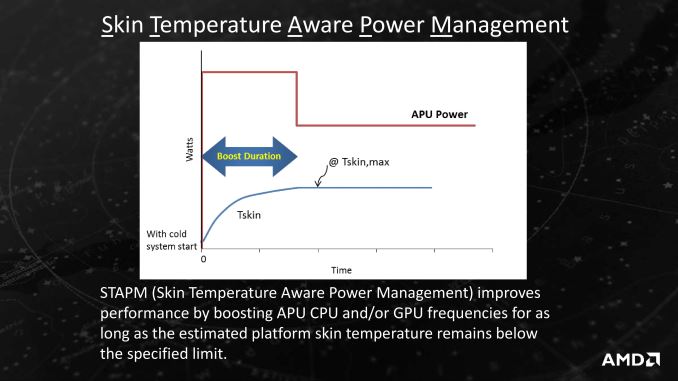
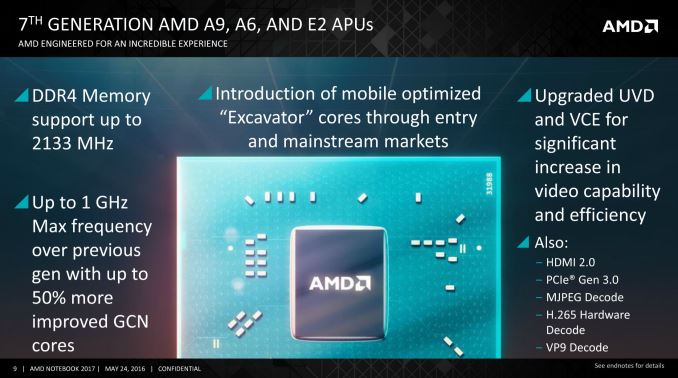
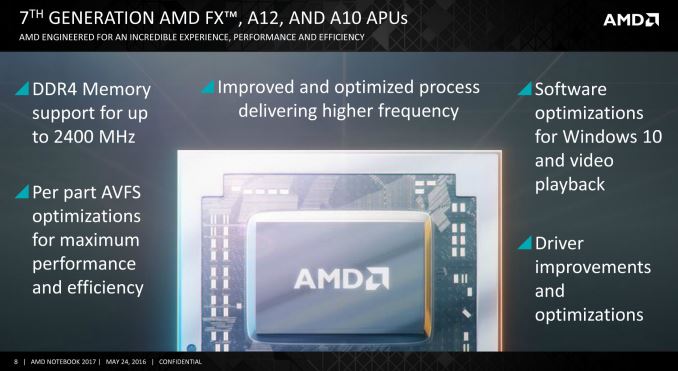
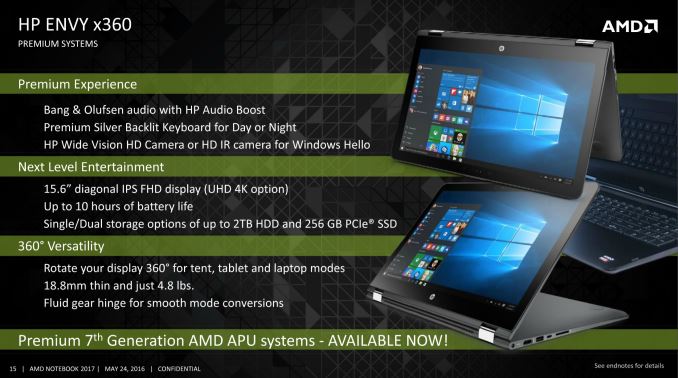

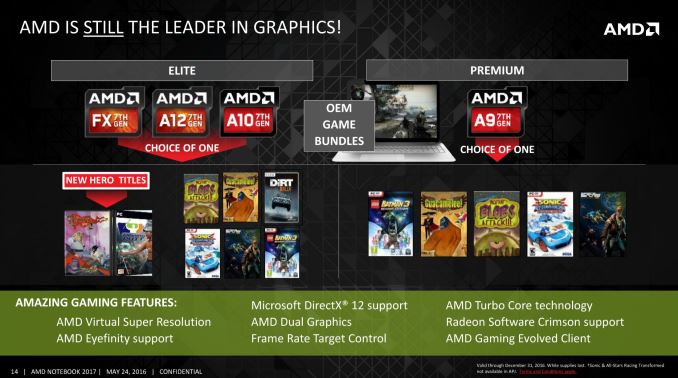













69 Comments
View All Comments
Eden-K121D - Tuesday, May 31, 2016 - link
We already have articles. niceMeteor2 - Wednesday, June 1, 2016 - link
'FX 9830P' AMD has terrible branding. It's makes no sense.Intel's m3/5/7 and i3/5/7 is so much clearer to a consumer.
mickulty - Wednesday, June 1, 2016 - link
"G3258"ZeDestructor - Wednesday, June 1, 2016 - link
Going by Metero2's example, that would be the Pentium, and nothing more.We just call it the G3258 cause we care what exact chip.
jjj - Wednesday, June 1, 2016 - link
Is it really? Intel's branding is made to mislead. i7 low power gets you nothing good but the average consumer thinks it's a good performing part just because of its label.UtilityMax - Friday, June 3, 2016 - link
Heh, Half of people I know bought high end laptops with i7 U CPUs (low power) for "number crunching".T1beriu - Wednesday, June 1, 2016 - link
If you're comparing with Intel's i3/5/7 remember that AMD has E2/6 A8/10/12/FX branding lines.Meteor2 - Saturday, June 4, 2016 - link
That's my point. Is FX higher or lower than A? What's the significance of X?gruffi - Friday, June 10, 2016 - link
Has i5 2 or 4 cores? What does the X in i7-6950X mean? Intel's naming scheme is worse in my opinion. It can be awkward and confusing, especially if you compare different market segments.FelG - Thursday, September 14, 2017 - link
Well, Intel is much more confusing. Bcos they dont state anything. For example. When you buy at the market. You can see an i7. You thought having an i7 will be great. But you need some education on intel's money-tech man. Bcoz Intel have this U - UltraLow versions, which are slow and what you buy is just the Intel and i7 name. The Base version with no U or K version and the K - Unlocked version and for money sake. Celeron and Pentiums have the same CPU stickers. Core i3U, i3, i5U, i5, i5K, i7U, i7, i7K have all the same background logo sticker design. The difference is just the numbers 3, 5 and 7. Of course you can include the i7 premium with having gray colored sticker but its only that. Unlike AMD you can even differ what is better by simply looking at their stickers. AMD E1 and E2 have plain white background. AMD A4, A6 have plain red backgrounds. A8, A10 have this red abstract backgrounds and FX have more complex abstract background. Even just by looking at their stickers. You can tell what AMD series are Higher.